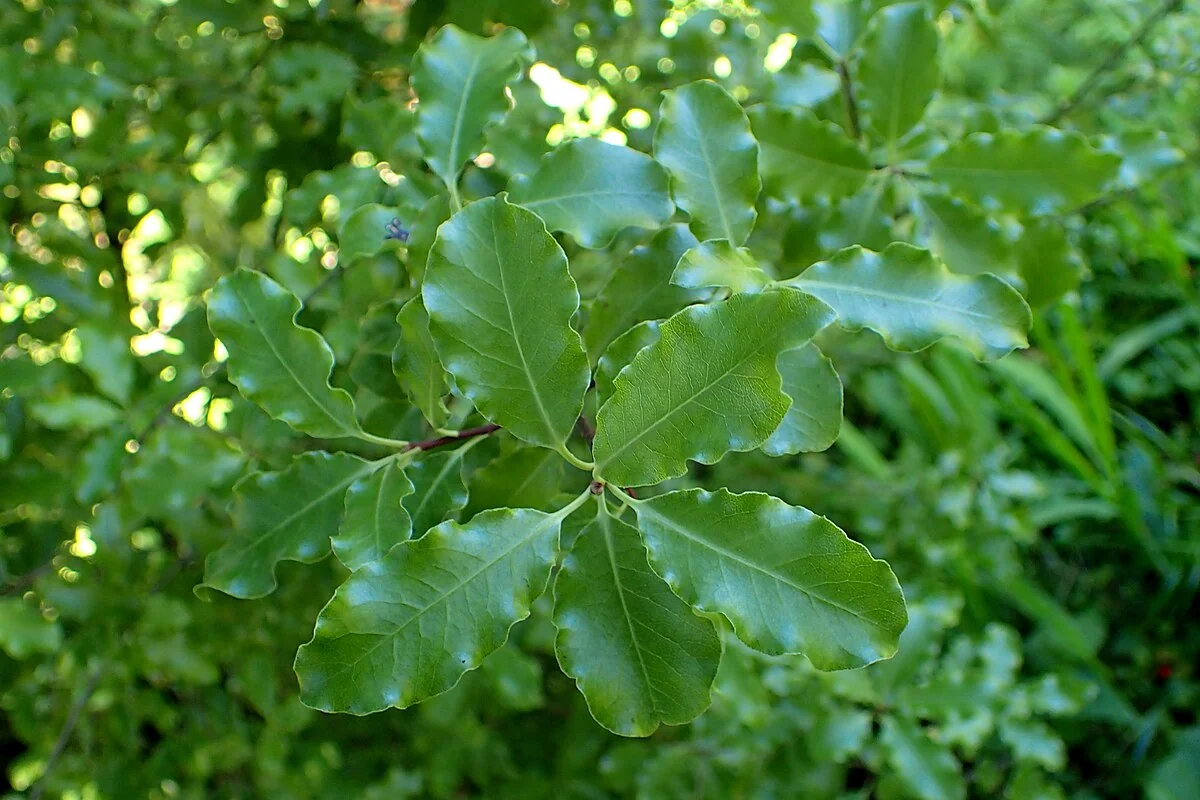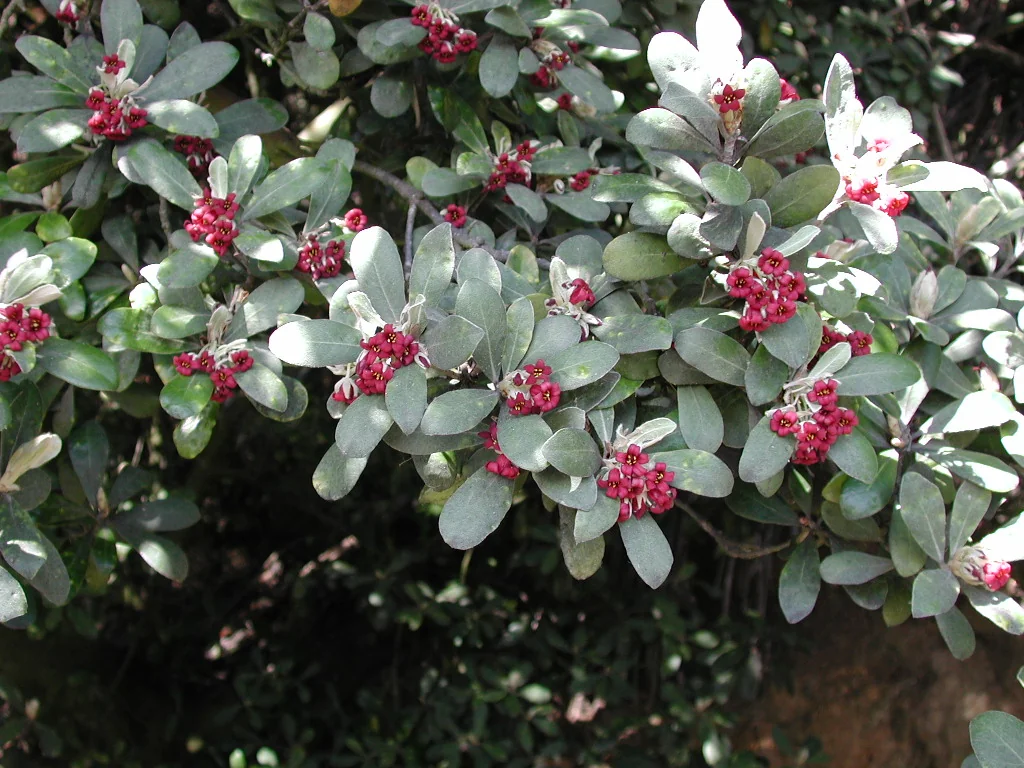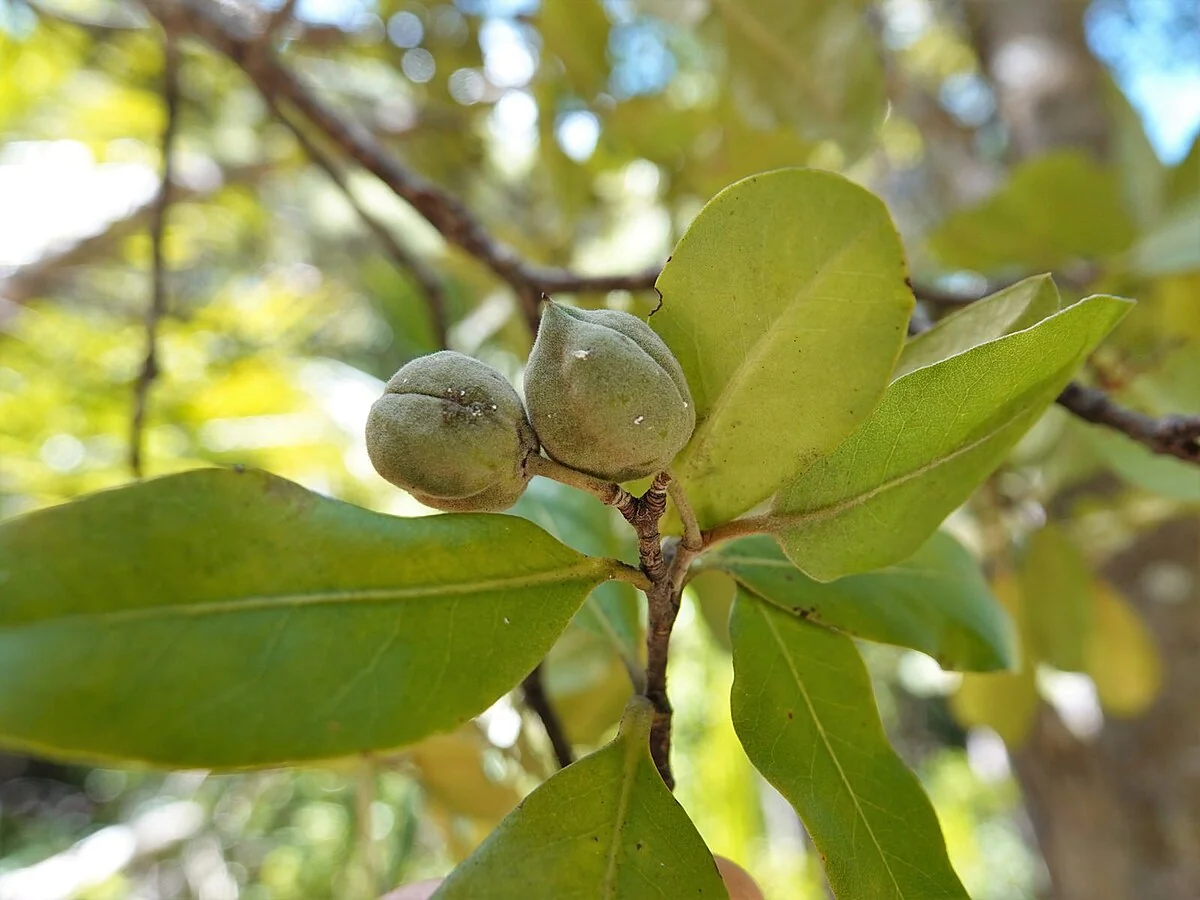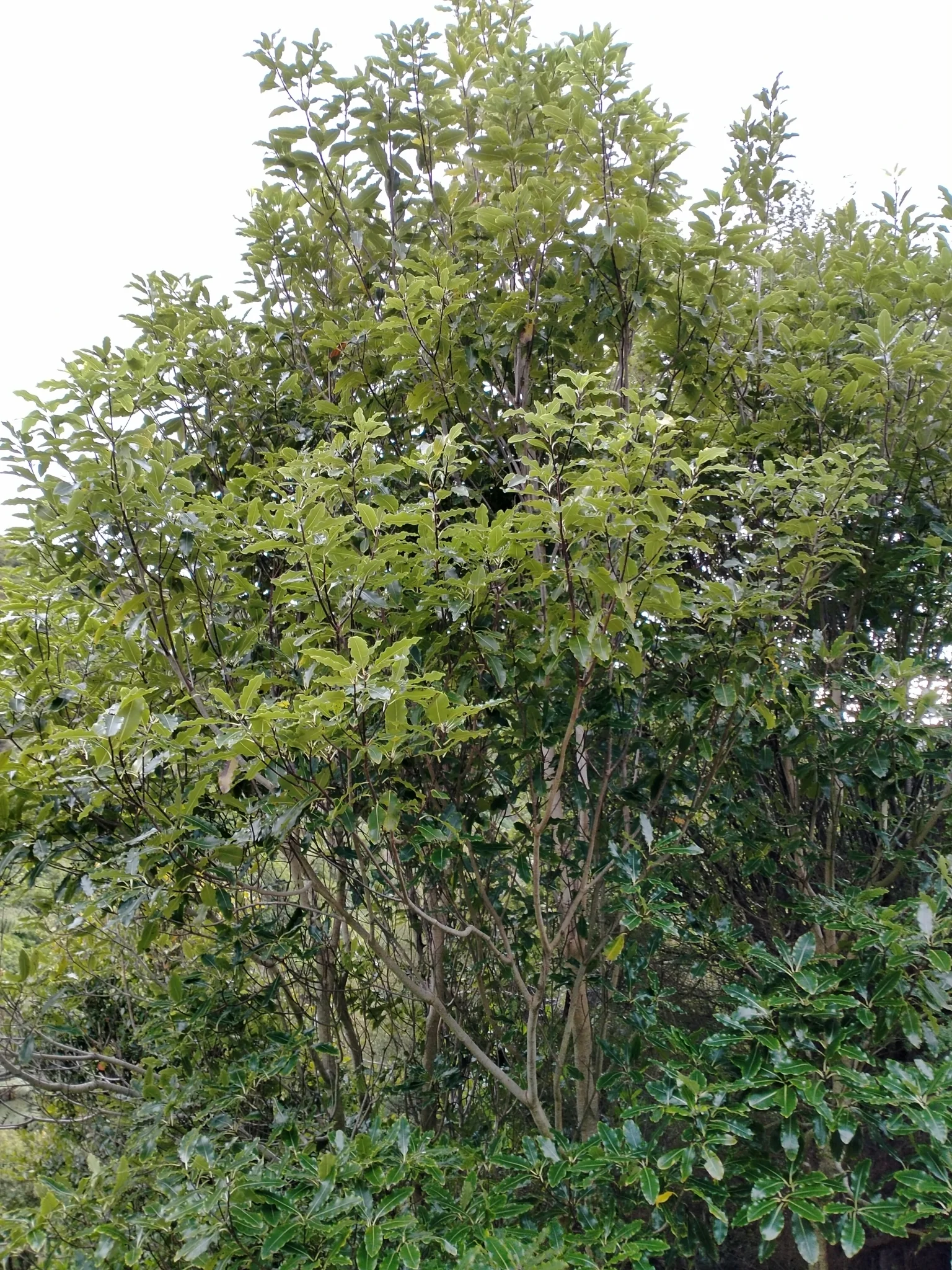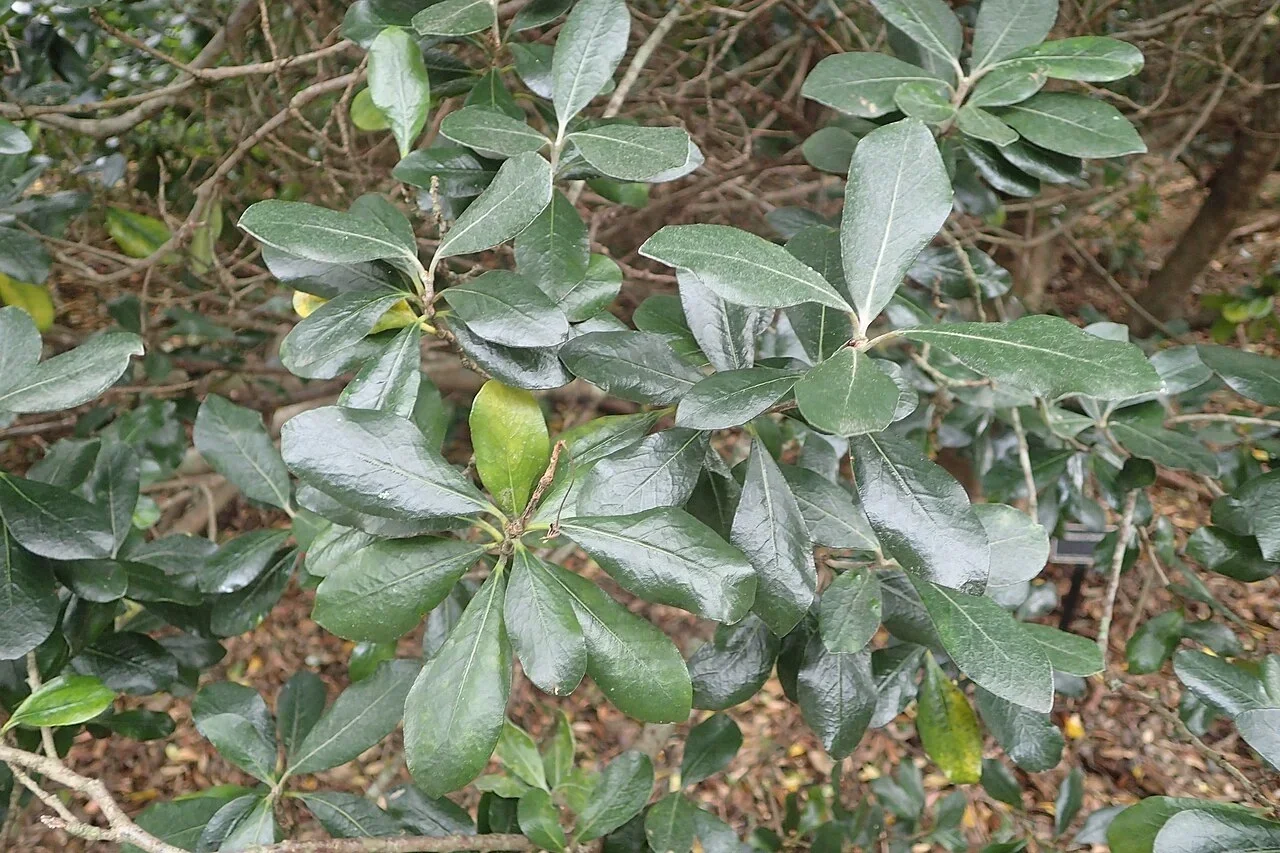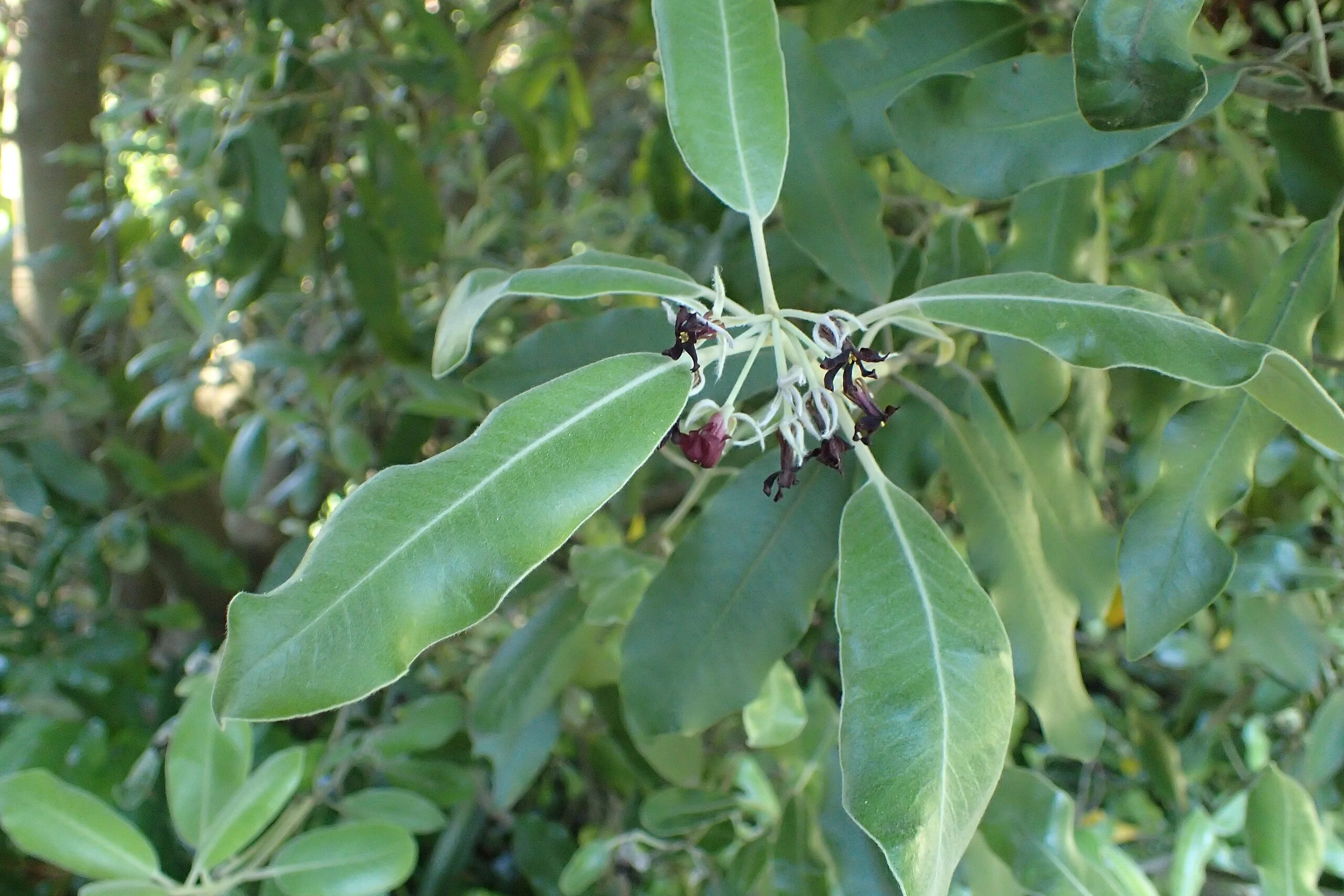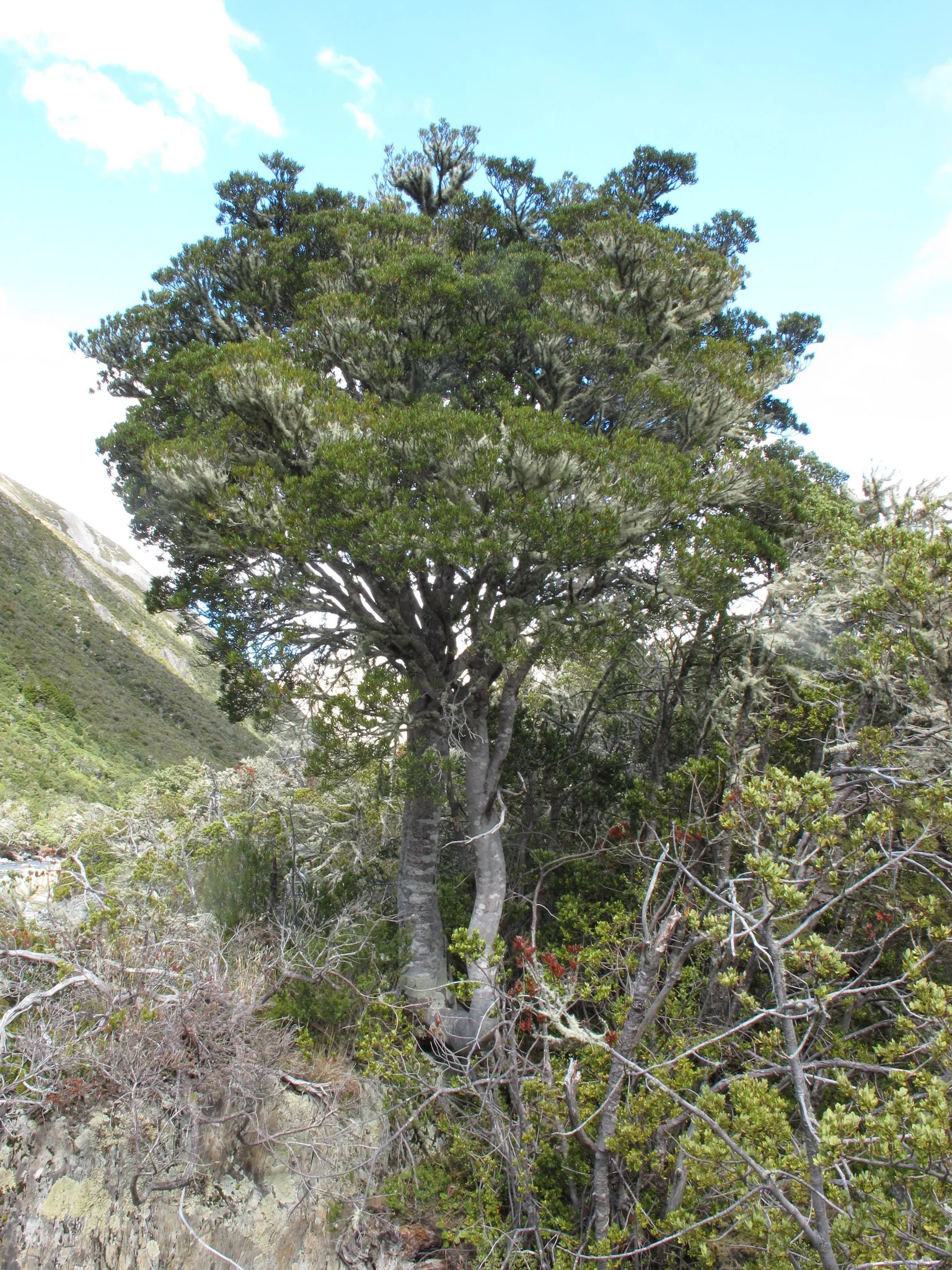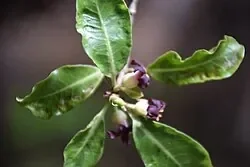
Kōhūhū
Pittosporum tenuifolium
Pittosporum tenuifolium , known by its Māori names Kōhūhū, Kohukohu, or Black Mātipō, is one of New Zealand's most beloved and widely cultivated endemic species, representing a pinnacle of horticultural excellence among native plants. This elegant gynodioecious tree reaches up to 10 m tall with a distinctive stout trunk 0.3-0.6 m in diameter, clad in characteristic dark grey-black or brown persistent bark that creates stunning architectural contrast in garden settings. The species epithet "tenuifolium" (thin-leaved) refers to its distinctive alternate leaves measuring 10-70mm x 5-20mm, which are leathery, pale-green to dark green, and elegantly oblong to elliptic-obovate in shape, creating the fine-textured foliage that makes this species so prized for topiary and hedging applications. From October to December, this remarkable endemic produces solitary or cymose flowers with 12mm petals typically in dark red or black (rarely yellow or white), followed by January-March fruiting that supports native wildlife and provides propagation opportunities. Endemic and widespread throughout New Zealand from coastal to montane shrubland and forested habitats, this adaptable species particularly favors successional environments, making it invaluable for restoration projects and challenging garden sites where its exceptional tolerance for diverse conditions, ease of propagation from fresh seed or semi-hardwood cuttings, and outstanding performance as shelter, hedge, or specimen planting have established it as the quintessential New Zealand native for both professional landscaping and home gardening applications. Learn more in our native plants guide .

Plant Description
Botanical Features
Kōhūhū ( Pittosporum tenuifolium ), also known as black matipo or kohukohu, is an evergreen shrub or small tree native to New Zealand. It can grow up to 8-10 meters tall, though many cultivated varieties range from 1 to 4 meters. It has attractive, often shiny, wavy-edged leaves that can be variegated and come in shades of purple, yellow, green, or silver-grey. The Latin name "tenuifolium" means "slender-leaved" or "thin-leaved." Young leaves may have fine hairs, while adult leaves are smooth and glossy. The stems are typically dark, ranging from gray to nearly black on young shoots. Small, dark reddish-purple to almost black flowers appear from late spring to early summer. These flowers are often inconspicuous but are highly scented, especially at night and in damp conditions, giving off a honey-like fragrance that attracts moths. Fertilized flowers develop into small, globe-shaped fruits that turn almost black and split open when ripe, revealing seeds encased in a sticky fluid.
Quick Facts
Overview
| Scientific Name | Pittosporum Tenuifolium |
|---|---|
| Height | 6-10 m |
| Spread | 3-6 m |
| Light | Sun to partial shade |
| Water Needs | Moderate |
| Frost | Good |
| Frost Tolerance | Hardy once established |
| Salt Tolerance | Moderate; tolerates coastal conditions |
| Growth Rate | Fast growing |
| Lifespan | Long-lived |
Climate Best Suited to
Pittosporum tenuifolium demonstrates exceptional adaptability across New Zealand's diverse climatic zones, naturally occurring from coastal environments to montane regions throughout the entire country where it thrives in successional habitats and diverse forest types. This hardy endemic species shows remarkable resilience to climatic variations, performing excellently in humid coastal conditions, exposed windy sites, and diverse inland environments while maintaining its elegant form and distinctive dark bark characteristics. Its widespread natural distribution across all New Zealand regions reflects outstanding tolerance for seasonal variations, salt exposure, and challenging growing conditions, making it ideal for gardens from subtropical Northland to temperate Southland climates.
Regional Suitability
| City | Climate Suitability |
|---|---|
| Whangārei | Ideal |
| Auckland | Ideal |
| Hamilton | Ideal |
| Tauranga | Ideal |
| Rotorua | Ideal |
| Gisborne | Ideal |
| New Plymouth | Ideal |
| Napier | Ideal |
| Whanganui | Ideal |
| Palmerston North | Ideal |
| Wellington | Ideal |
| Nelson | Ideal |
| Christchurch | Ideal |
| Dunedin | Ideal |
| Invercargill | Ideal |
Natural Habitat
Kōhūhū ( Pittosporum tenuifolium ), also known as black matipo or kohukohu, is an evergreen shrub or small tree native and endemic to New Zealand. It is widely distributed across both the North and South Islands, thriving in a variety of habitats from coastal areas to lower mountain forests, reaching altitudes up to 900 meters (nearly 3000 feet).
Preferred Conditions:
- Forest Margins and Clearings: It is commonly found in forest margins, regenerating areas, and open woodlands, where it benefits from varied light conditions.
- Well-Drained Soils: Kōhūhū prefers light and well-drained soils. While it can tolerate poor conditions, including less fertile soils and droughts, it does not thrive in areas with damp conditions, such as the West Coast of New Zealand, as this can lead to winter leaf drop.
- Coastal and Inland: This hardy plant can tolerate coastal winds and is found in both coastal and inland environments, showcasing its adaptability.
Distribution:
- Widespread: Its widespread distribution throughout New Zealand highlights its ecological flexibility and ability to adapt to diverse climatic conditions.
- Successional Habitats: It is often found in successional habitats, playing a role in the natural regeneration of forests.
The presence of Pittosporum tenuifolium in these diverse habitats underscores its ecological importance in contributing to the biodiversity and structural complexity of New Zealand's native forests.
Plant Conservation
Pittosporum tenuifolium , also known as kōhūhū or black matipo, is a small evergreen tree endemic and widespread throughout New Zealand, its native range. It is found in coastal to montane shrubland and forested habitats, preferring successional habitats.
The NZPCN lists its current conservation status as "Endemic and widespread throughout country," indicating that it is not currently considered threatened in its native habitat.
While it is native to New Zealand, Pittosporum tenuifolium has naturalized in other regions, including Victoria, Tasmania, and New South Wales in Australia, and California in the United States. In some of these areas, it is considered an invasive species.
Growing Requirements
Soil
Well-drained, moderately fertile soils; avoid prolonged waterlogging.
Light
Performs in full sun to partial shade depending on species.
Water
Keep evenly moist while establishing; reduce irrigation as roots develop.
Temperature
Hardy in most regions of Aotearoa once established.
For Kōhūhū ( Pittosporum tenuifolium ), choose a site with sun to partial shade and soil that is well-drained, moisture-retentive. Incorporate composted organic matter to improve structure and drainage. Plant with the crown or root collar at soil level, then apply a 5-8 cm mulch to moderate temperature, conserve moisture, and suppress weeds. Protect young plants from extremes while establishing and consider the stated frost tolerance (seasonal) when siting near exposure or cold air drains.
Planting Guide
Kōhūhū is one of New Zealand's most beloved and widely cultivated native plants, renowned for its versatility, attractive foliage, and ease of care. Whether you're aiming for a formal hedge, a specimen tree, or a windbreak, proper planting and ongoing maintenance will ensure your Kōhūhū thrives.
1. Ideal Growing Conditions:
- Sunlight: Kōhūhū performs best in full sun to partial shade. While it can tolerate some shade, optimal growth and flowering are achieved in locations receiving ample sunlight throughout the day.
- Soil: It prefers well-drained, moderately fertile soils. It is highly adaptable to a wide range of soil types, including sandy, loamy, and even heavy clay soils, provided there is good drainage. Avoid prolonged waterlogging. A neutral to slightly acidic pH is generally suitable.
- Climate and Tolerance: This hardy tree is tolerant of coastal conditions, wind, and moderate frosts once established. It is widely distributed across New Zealand, reflecting its adaptability to diverse climates.
2. Planting Instructions:
- Timing: Spring is the ideal planting season for Kōhūhū, allowing it to establish strong roots before summer. Autumn planting is also suitable in milder climates.
- Preparation: Prepare the planting site by clearing weeds and enriching the soil with compost or other organic matter to improve fertility and drainage. Dig a hole that is twice the width of the root ball and to the same depth.
- Root Care: Gently tease out any pot-bound roots before placing the plant in the hole.
- Placement: Ensure the top of the root ball is level with the surrounding ground. Backfill the hole with soil, gently firming it around the roots to remove air pockets.
- Watering: Water thoroughly immediately after planting to settle the soil.
- Spacing: For hedging, space plants 50-100 cm apart. For specimen trees, allow at least 3-5 meters for its mature spread.
3. Ongoing Care:
- Watering: Water regularly during the first year to help establish a strong root system. Once established, it is relatively drought-tolerant but benefits from consistent moisture during hot, dry weather.
- Mulching: Apply organic mulch around the base of the plant to retain moisture and suppress weeds, keeping the mulch clear of the trunk.
- Fertilizing: A light application of a balanced, slow-release organic fertilizer in spring can support healthy growth, but avoid overfeeding.
- Pruning: Kōhūhū responds exceptionally well to pruning. Regular trimming is essential for hedges and topiary. For specimen trees, light formative pruning may be beneficial in the early years to encourage good structure. Essential pruning includes removing dead, damaged, or crossing branches, ideally conducted in late winter or early spring. Use clean, sharp tools.
- Pests and Diseases: Kōhūhū is generally robust, but monitor for common pests like aphids or scale insects. Ensure good air circulation to prevent fungal issues.
Ecosystem Notes
- Habitat: Tolerant of wind and dry spells once established on free-draining soils.
- Wildlife: Provides shelter and seasonal nectar/pollen for insects and birds.
- Restoration: Useful in shelterbelts and native hedges to protect young plantings.
Uses and Significance
Garden and Restoration
Kōhūhū excels as New Zealand's premier native species for formal landscaping applications, offering unmatched versatility for hedging, topiary, shelter belts, and specimen planting with its distinctive dark bark, fine-textured foliage, and exceptional tolerance for pruning and shaping. This outstanding endemic is particularly valued for its rapid establishment, reliable performance across diverse site conditions, and ability to provide year-round structure while supporting native ecosystems through its October-December flowering and January-March fruiting periods that attract native birds and beneficial insects.
- Premier hedging and topiary species with exceptional pruning tolerance
- Outstanding shelter belts, windbreaks, and architectural specimen plantings
Raise Kōhūhū from seed collected when ripe, or by semi-hardwood cuttings set under intermittent mist. Use sharp, disease-free material and maintain moderate warmth and bright, indirect light for rooting.
Landscaping Ideas
Premier Native Hedge
- Hedges/topiary: Responds well to clipping; hold formal shapes or soft screens.
- Specimen: Dark bark and fine foliage give year-round structure.
- Mixed screens: Combine with Griselinia , Coprosma , and Olearia .
Seasonal Care Calendar
Spring
- Plant and mulch
- Protect new growth from weeds
Summer
- Deep watering in drought
- Monitor pests
Autumn
- Light formative pruning
- Top up mulch
Winter
- Plant eco-sourced stock
- Stake in windy sites
Pruning and Maintenance
Techniques and Timing
Generally minimal; formative work when young and removal of damaged wood.
Prune Kōhūhū lightly to maintain structure; remove damaged shoots and avoid hard cuts on older wood.
How to Grow Kōhūhū
Growing Kōhūhū successfully is remarkably straightforward, making it one of New Zealand's most reliable and versatile native plants for cultivation. This fast-growing species adapts to a wide range of conditions from alpine environments to coastal areas, demonstrating exceptional hardiness and resilience. Understanding its natural growth patterns and environmental preferences enables gardeners to achieve optimal results whether growing it as a specimen tree, formal hedge, or shelter belt. The plant's tolerance for poor soils, drought conditions, and windy environments, combined with its relatively rapid growth rate, makes it an excellent choice for both novice and experienced native plant gardeners seeking reliable establishment and performance.
From Seed
Seed propagation offers excellent results with Kōhūhū, though understanding proper seed handling and treatment significantly improves germination rates and timing. Fresh seed provides the best results, while proper preparation removes natural germination inhibitors for more reliable establishment.
- Collect fresh seed from ripe orange capsules in autumn when they naturally split open
- Remove the sticky coating from seeds before sowing, as this substance acts as a germination inhibitor
- Clean seeds thoroughly in warm water to remove all sticky residue and pulp
- Apply cold stratification treatment for 6 weeks at 4°C to simulate natural winter conditions
- Sow seeds individually in small pots during spring for best results
- Use well-draining seed-raising mix with good moisture retention capabilities
- Place containers in a sheltered outdoor location with filtered sunlight
- Maintain consistent moisture levels without waterlogging throughout germination period
- Be patient as germination takes 2-4 months, often extending longer under cooler conditions
- Transplant seedlings when they have developed robust root systems and multiple leaf sets
- Expect rapid growth once established, reaching 0.5-3 meters within five years
From Cuttings
Semi-hardwood cuttings provide reliable propagation results with Kōhūhū, offering faster establishment than seed and maintaining parent plant characteristics. This method works particularly well when provided with warmth and humidity during the rooting period.
- Take semi-ripe cuttings of young, healthy, vigorous shoots during mid to late summer
- Select non-flowering shoots from current season's growth that has begun to firm up
- Cut 8-12cm long sections using sharp, sterilized cutting tools
- Remove lower leaves while retaining 4-6 leaves at the cutting tip
- Dip cutting bases in rooting hormone powder containing IBA at appropriate concentration
- Plant in well-draining propagation mix such as equal parts peat moss and perlite
- Provide bottom heat at 18-22°C to encourage rapid root development
- Maintain high humidity using propagation domes or mist systems
- Place in bright indirect light, avoiding direct sunlight that can stress cuttings
- Monitor for root development after 4-6 weeks by gently checking for resistance when tugged
- Gradually acclimatize rooted cuttings to normal growing conditions over several weeks
From Layering
Layering provides an alternative propagation method that works well with Kōhūhū's flexible branching habit. This technique requires patience but offers excellent success rates for producing new plants while maintaining connection to the parent plant.
- Select healthy young shoots growing near ground level during the growing season
- Bend flexible branches down until they touch the soil surface
- Use a sharp knife to remove a small sliver of bark at the soil contact point
- Apply rooting hormone to the wounded area to encourage root development
- Peg the branch firmly in place using wire pegs or stones to maintain soil contact
- Cover the contact point with quality potting mix or compost
- Keep the layered area consistently moist throughout the rooting period
- Leave in place for 6-12 months until strong root systems have developed
- Check root development by gently excavating the layered area
- Sever from parent plant once well-rooted and transplant to desired location
Site Selection and Establishment
Successful establishment of Kōhūhū requires understanding its adaptable nature while providing optimal growing conditions. Proper site preparation and initial care ensure rapid establishment and long-term success in various garden applications.
- Choose sites with sun to partial shade, though the plant prefers good light levels for optimal growth
- Ensure well-drained soil with good moisture retention, incorporating organic matter if needed
- Plant with the crown or root collar at soil level to prevent root rot or collar rot issues
- Space plants appropriately: 1-2 meters apart for hedging, wider spacing for specimen trees
- Apply 5-8cm of organic mulch around plants to moderate temperature and conserve moisture
- Water regularly during the first two growing seasons to establish strong root systems
- Consider the plant's eventual size when positioning, as it can reach 10 meters in optimal conditions
- Take advantage of the plant's excellent wind tolerance for shelter belt applications
Ongoing Care and Management
Established Kōhūhū requires minimal maintenance while providing excellent garden performance and versatility. Understanding proper nutrition, watering, and pruning practices ensures healthy, vigorous plants that fulfill their intended garden roles effectively.
- Adjust watering to local rainfall patterns once plants are fully established
- Apply slow-release organic fertilizer in spring, avoiding over-fertilization that promotes weak growth
- Maintain weed-free root zones and renew organic mulch annually
- Prune carefully to maintain desired form, avoiding severe heading cuts that stress plants
- Remove only dead, damaged, or crossing branches during regular maintenance
- Shape hedges regularly to maintain dense, formal appearance when used for formal landscaping
- Appreciate the plant's fragrant flowers and attractive foliage throughout the growing season
- Utilize the plant's excellent performance as New Zealand's premier native species for formal applications
Pests and Diseases
Common Problems and Solutions
Kōhūhū ( Pittosporum tenuifolium ) is generally resilient, though psyllids can cause leaf-cupping in warm, sheltered sites. Encourage predators and avoid high-nitrogen feeding; a spring compost mulch and good airflow usually keep foliage clean.
Cultural Significance
Pittosporum tenuifolium , commonly known as kōhūhū, black matipo, kohukohu, or tawhiwhi, holds significant cultural importance, particularly among the Māori people of New Zealand, its native land.
Its cultural significance Is Multifaceted:
- Traditional Māori Uses: The Māori people traditionally utilized various parts of the kōhūhū plant. The resin and oils extracted from its leaves were highly valued for their scent and were often mixed with ingredients from other native trees to create perfumes. These scented oils were used to fragrance small pouches, the skins of dead birds worn around the neck, and to scent the homes and mats of high-ranking individuals. The wood of the Pittosporum was also fashioned into weapons and utensils.
- Medicinal Properties: Kōhūhū was incorporated into traditional Māori medicine to treat various ailments, with studies supporting its antimicrobial properties.
- Ceremonial Role: The leaves and branches of kōhūhū played a role in sacred Māori ceremonies, including baptisms. Today, they are still used in welcoming ceremonies for visitors to a marae (a Māori meeting place), a practice reflected in its Māori names tāwhiri ("to wave to") and rautāwhiri ("to wave a leaf").
- Ecological Value: Beyond its direct human uses, kōhūhū is ecologically significant in New Zealand, supporting native biodiversity and contributing to habitat structure. It is valued in restoration efforts and garden plantings, with its flowers attracting native birds and beneficial insects.
- Historical Navigation: Anecdotally, European sailors are said to have used Pittosporum as a landmark for navigation during their voyages.
In modern horticulture, Pittosporum tenuifolium is a popular garden plant both in New Zealand and internationally. It is widely used for hedging, topiary, shelter belts, and as a specimen plant due to its adaptability, rapid growth, and tolerance for pruning. Its distinctive dark bark, fine-textured foliage, and various cultivated forms with purple, silver, or variegated leaves are highly prized.
Bonus Tip
Expert Growing Advice
The Māori people in New Zealand traditionally use the oil from the plant as a perfume due to its pleasant fragrance and medicinal properties. Its small, dark reddish-purple flowers, though often unnoticed, release a sweet, honey-like scent at night, which attracts moths and other night-flying insects for pollination.
